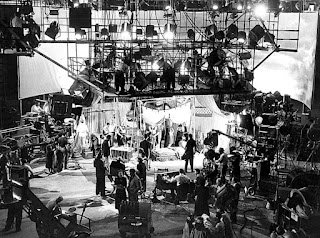Have you ever thought about making a movie? Sure you have, so let us have a go at it.

Books, stage shows, television series and movies are made to ‘make the almighty dollar’. Our pop culture is based on what fad at the time sells.


This process can also be done in the storyboards. These are visual images try to relate the ideas in the scriptwriter’s mind to people who will point the cameras. These sketches are a kind of blueprint for big scenes vs close ups but doesn’t have to be detailed to fades or pans that the director will choose.

Next you will have to find some actors (actresses) to perform the script in your movie. You can try and get Hollywood stars (starlets) but they cost big bucks. They have a name and can be a draw to the potential audience but at what a cost? You can try out unknowns with talent but no one knows who they are and they will have to give an outstanding performance for the critics to give them any recognition. At the same time they might be the ‘next’ breakthrough actor to become Hollywood’s next walk of fame.
Now you got your cast learning their lines, you’ve got to get the extras. You know, all those folks who are milling about in the background trying not to look at the camera. For a small budget film it might just be a few. A policeman or a cook or a butler might be all you need. A blockbuster is going to need hundreds of bodies to make armies or crowd scenes running from the monster. Today much of this can be in computer generated technology. Instead of all these folks standing around needing to be fed and dresses and paid for a couple of inches of film it can be a few clicks of the mouse.

Unless you are making a sex exploitation movie, the characters will need a clothed. Fashion designers will need to be hired to design costumes that will fit the period of your movie. A wardrobe department will be needed to sew and fit and repair details for each actor, whether star or extra. Each outfit might wind up in a museum or a garbage dump.
Where are you going to film this masterpiece? The movie set could be a
producer’s back lot sound stage or some far away dessert. A city landscape or a
single room must give a feel for the movie. A western cannot be made in a
shopping center parking lot. That means spaces will need to be rented. Trailers
for the actors will be hauled in and tents for the extras. Expect rain when not
wanted and delays for everything from lost of power to outside noise. All the
time the ticker is running and money is flying out the window.
How is your budget holding up so far? You are spending money without a single frame being filmed.
Now you got actors and extras and costumes and sets, you need someone to film them all together. A director to set up the scenes is necessary. He or she will be the traffic cop to keep everything moving. Of course, a director will need an entourage of assistants.
Next will be the folks who actually point the cameras and turn them on when the director says, “Action”. Lighting and sound all have their own crews. None of this stuff is cheap.
You might get some financial sponsors by placing their product in scenes? You got to get money wherever you can find it.
Now all the scenes have been shot, the script read and everything is ‘in the can’ (that is movie speak) the director says, “That’s a take”.

Editing. This process can take as long as shooting the movie itself. Each frame will have to be examined to check every little detail. Does the sound match the mouth movements of the actors? Did the scene go too long? Did the explosion work well and from which angle? Did a shadow get in the face of a star performance? You don’t want to have to call everyone back together again for a re-shoot.
Again, computers can touch up many a flaw.


Prepare for the ‘Premiere’ showing of your movie to the public (and critics)! Not so fast. There is still marketing. Posters and trailers and even tickets will need to provide enticement to the public. Put on your best attire and send out invitations for the who’s who of movie reviews and hope for the best.

The next day buy all the newspapers and read the reviews through your hangover. Remember to go to the social media podcast. Now measure your score.
Will major theatre chains pick you up for extended runs or will you be shown in back alley theatres to eclectic audiences hoping to become a cult favorite?
Did you forget the copyrights and streaming deals and royalties and…



